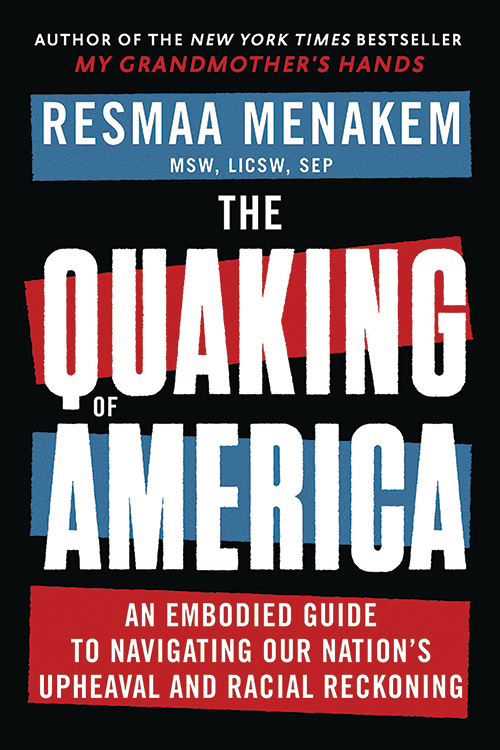
The Quaking of America: An Embodied Guide to Navigating Our Nation’s Upheaval and Racial Reckoning
Reviewed by Patience A. Schenck
January 1, 2023
By Resmaa Menakem. Central Recovery Press, 2022. 384 pages. $34.95/hardcover; $18.95/paperback or eBook.
This unusual book is difficult to describe. It is compelling; very disturbing; and helpful, especially if one adopts the author’s practices.
Readers who have read Resmaa Menakem’s earlier book, My Grandmother’s Hands (2017), know that he is a trauma therapist who offers healing techniques to people who want to make the world a better place. The earlier book addresses trauma in White people; Black people; and police officers—regardless of race—with all their different experiences. His practices are designed to help them stand up to racism. This book, on the other hand, is written for people who want to save democracy in the United States. He writes: “The Quaking of America is a book of practical, embodied psychology that will help you be ready for what is to come.” He continues: this book is “about preparing your body and community for a civil war—and, if possible, preventing it.” Later he emphasizes this point again: “we need to begin not with strategy or politics, but with tempering and conditioning our bodies.”
The author lays out at considerable length the threats he sees to our democracy. It is not a pretty picture. He predicts a civil war, not organized like the first Civil War but more akin to the rioting at the Capitol on January 6, 2021, waged in communities across the country. He describes attempts to deny the legitimacy of the 2020 election; limited voting, especially by People of Color; and elected secretaries of state committed to overturning future elections. He points out that most rioters on January 6 and those who refuse to condemn them are White Christians born in the United States, suggesting that White, native, Christian supremacy is at the center.
Then he outlines the theory and practice of healing from trauma, preparing us to stand up to the threats to democracy. He asks us to actually do the exercises as we read and then incorporate them into our daily lives: we won’t just read this book; we will do it.
Menakem believes that trauma is carried in our bodies, and that is where healing must occur. If trauma is activated, he tells us to slow down; settle our bodies; and notice the tension in them rather than act out in difficult situations. He advises his readers to respond from the best part of themselves. People I know who have used his techniques have noticed that chronic stresses have in fact stopped interfering with their current ability to cope, which he calls the “metabolizing” of trauma. I am committed to a different healing modality, but I found that his practices made me more aware of my reactions to stressful situations and helped me better deal with them.
While we are all different as individuals, Menakem often gives White people and People of Color different healing practices because members of each group share certain experiences. Because of the importance of the body, he refers consistently to White people as “white bodies” and People of Color as “bodies of culture.”
Besides outlining the dangers we may face and showing us how to heal and prepare our bodies, the author suggests ways we can prepare to get into the thick of things, such as training in self-defense, learning basic first aid and CPR, training in nonviolent resistance, and carrying with us the name and phone number of a good civil rights lawyer.
Menakem’s goal is to build a “living, embodied, antiracist culture.” He is not confident that this will happen quickly; he even suggests that it may take many generations to obliterate racism. But we must work toward this goal now if we are to save our democracy.
This is a fascinating book, written with a sense of great urgency. We know that he decided to write it after the events of January 6, 2021, and that the book came out in early 2022, so he wrote it in less than a year. His urgency shows in the somewhat disorganized presentation with no index and technical terms used in chapters before they are defined or explained. However, his sense of urgency is part of the message, one that we all need to hear. His ideas are helpful; he calls us to our deepest integrity; and he gives us tools to encounter challenging times.
Patience A. Schenck is a member of Annapolis (Md.) Meeting living at Friends House in Sandy Spring, Md.



Comments on Friendsjournal.org may be used in the Forum of the print magazine and may be edited for length and clarity.